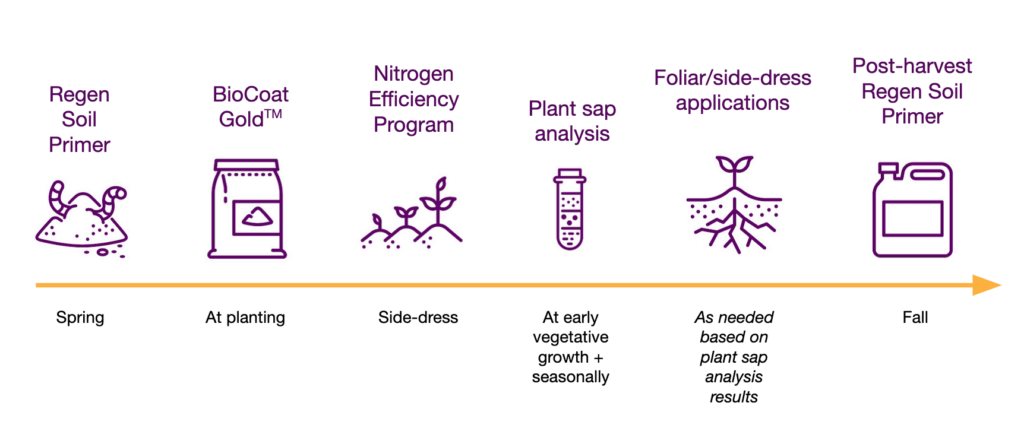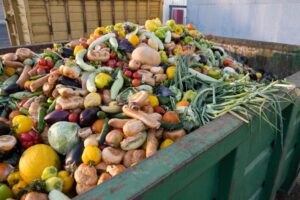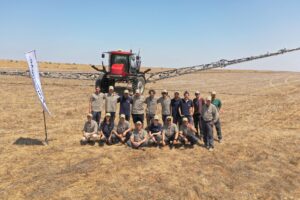If you’ve met John Kempf you’ll remember.
His appearance is one thing; he’s Amish and dresses accordingly. The silhouette of his boater kapp has become a trademark in a US agriculture industry characterized by plaid shirts and jeans and, increasingly, men in suits. But it’s also his passion and deep understanding of regenerative agriculture that sets him apart. When you find out he started a regenerative agriculture business at just 18-years old, fours year after starting to work on his family’s farm in Ohio with just an eighth-grade education, he’s even more memorable.
By 2016, he’d worked with over 10,000 US-based farmers — sure, most were relatively small scale and within the Amish and Mennonite communities he grew up in but that’s still a big number. And today, as the size and scale of farms he works with increases, he counts some of the world’s leading agrifood companies as clients in a footprint of over 4 million acres across North America.
He’s not stopping there. “My personal mission, which I’m passionate about, is having regenerative agriculture become the standard status quo for more than 80% of the world’s farmers by 2040 globally. I think this is a realistic goal,” he tells AFN.
Today Kempf and his team at Advancing Eco Agriculture (AEA) have raised $4.7 million in financing — both equity and debt — in their first external round of funding. The financing was led by New York impact investment firm Tree Trunk Light with other non-equity financiers. Tree Trunk Light’s founder and managing director Paul Bergman was already executive chairman of AEA before the deal and will continue in that role.
Why it matters
Regenerative agriculture is a system of growing food that takes a more natural and holistic approach than that supported by large agribusinesses selling farming inputs like fertilizers, pesticides, and genetically-engineered seeds; it aims to eschew most of those products.
Regenerative agriculture is also a return to a more historic way of farming that many indigenous populations pursued before the Green Revolution introduced synthetically-made fertilizers and pesticides, and a formulaic method for using them to grow crops in abundance. The long-term negative impacts of what Kempf calls “contemporary” farming (‘conventional ag’) are well documented: extractive, greenhouse gas-emitting crop input manufacturing; suffocating algal blooms and soil degradation from the excessive use of such inputs; low nutrient density and taste in food; concentrated animal feeding operations and the resulting pollution, to name a few.
Various research has also shown that regenerative agriculture practices can produce more nutrient-dense foods, and also have the potential to sequester (remove) carbon dioxide from the atmosphere and store it in the soil causing many climate activists to promote it as a solution to climate change.
For Kempf and AEA, regenerative agriculture is as much about putting more money in farmers’ pockets by making their fields more profitable.
In a press release announcing the funding round, AEA says it has “improved the agronomics and economics of North American farmers for 16 years by focusing intently on soil and plant health,” helping farmers “reduce and often eliminate the need for herbicides and pesticides, while simultaneously improving the performance and profitability of the crop.”
How it works
There are three pillars to AEA’s regenerative agriculture business: advisory, a line of crop inputs, and data analysis.
Technical crop advisory
- AEA’s consulting provides farmers with the agronomic guidance they need to transition to regenerative agriculture.
- This involves creating customized crop programs, recommending soil amendments, microbial inoculants, crop input products, water quality corrections, cultural management practices, and cover crops; all the pieces that AEA says are appropriate to develop an integrated system for each farm.
Plant nutrition and biological products
- AEA manufactures and sells a range of regenerative plant nutrition products, some trademarked, which quickly reduce the need for typical synthetic fertilizers and pesticides, and can sometimes eliminate them entirely.
- These include a nutrient product called Rejuvenate to stimulate the soil microbiome ahead of/with planting, micro and macronutrient products such as “SeaStim” which supports the growth of beneficial fungal populations, and a bacterial inoculant called BioCoat Gold.
- AEA says its products are intended to be plant available without being water-soluble, which prevents them leaching, and provides nutrition when water supply is limited.
- Most of the plant nutrition products are developed in-house by AEA in collaboration with other labs and companies that manufacture its microbial inoculants.
Plant health and soil analysis
- AEA analyzes the health of farmers’ crops mainly through plant sap analysis, which Bergman likens to a human doing bloodwork.
- Undertaken in a lab, plant sap analysis shows plants’ mineral levels and highlights nutritional deficiencies and excesses that could impact a plant’s immune system and therefore its ability to resist pest and disease pressure.
- This is an alternative to plant tissue testing which AEA says is less specific or accurate and therefore presents a more limited picture of the health of a crop.
- AEA’s website says: “Monitoring the nutrients in plant sap provides some in-depth, practical insights into the factors which influence nutrient mobility at different stages of growth while providing the grower with information to empower data-driven management decisions.”
- AEA also utilizes soil microbiome analysis, and several types of soil nutritional testing to accurately evaluate a soil’s capacity to deliver nutrients and suppress potential pathogens. Growers commonly reduce fertilizer applications by as much as 30-40% while maintaining or increasing yields, as a result of deeper agronomic insights.
“When you increase plant health, you can’t prevent yields from increasing,” says Kempf.

Results and differentiation
Increasing numbers of agrifood companies are hiring regenerative agriculture business consultants like AEA to help them transition the farms they work with to regenerative practices, and while the overall mantra is similar, the approaches can differ as well as their target clients.
While AEA works with all crops today, historically it has focused more on fruits and vegetable farms where incorporating soil health-boosting livestock is not practical, for example. Kempf says that AEA has therefore had to invest more deeply in collecting data and measuring soil microbiome regeneration.
Other regen ag practitioners, such as the well-known Gabe Brown with his company Understanding Ag and Allan Savory of the Savory Institute, have tended to focus more on what Kempft calls “cultural management” of farmland, i.e. practice implementation such as cover cropping, rotations, and, especially, mob grazing cattle.
Kempf believes that focusing on plant nutrition and crops’ deficiencies and excesses as deeply as it does can accelerate the benefits of regenerative agriculture faster than other approaches. The company offered the following case studies as examples:
- James Johnson (cotton/onions, NW): reported 1,490 lbs/acre for Pima Cotton at the end of harvest season 2020 while the County average was 880 lbs/acre
- Greg Pennyroyal (wine grapes, CA): reported an average 27% yield increase, a 50% reduction in fungicides, a 40% overall reduction in water perton usage, and an increase in grape quality leading to better wines.
- Dan McClure (brassicas, WA): didn’t share numbers but said his plants were “growing much bigger and we seem to be having earlier harvests.”
AEA’s approach to innovation is also reasonably novel in regen ag. Aside from its clear affinity and use of novel biological and nutrient inputs, the company is keen to explore how digital technologies could play into its model. While its plant health data analysis is currently based on lab-based results which are relatively “analog”, the company is exploring other ways to capture data and would be interested in working with other external companies’ technologies where relevant, says Bergman. Part of the proceeds of today’s funding will also go to “building AI and tech platforms that will bring regenerative agriculture decision making and best practices directly to farmers,” reads the press release.
Kempf adds, however, that AEA’s mission is to accelerate all types of regenerative agriculture, which all have an important and effective role to play, and that the movement needs to work together to achieve his ambitious 2040 goal.
“We understand that we can’t have that impact alone as one organization, but what we can do is set an extremely high standard and bar of excellence and deliver agronomic results that force other agronomic companies to change how they do business as a result of our presence in the marketplace. Collectively we can create significant change,” he tells AFN. “I think [transitioning 80% of the world’s farms to regenerative agriculture by 2040] is a realistic goal and we’re well on the pathway to achieving that. In order to have that kind of implementation at scale, there needs to be a clear economic incentive; you achieve what you incentivize.”
What they say
John Kempf, founder AEA: “We don’t aspire to be the next Bayer or Nutrien; we aspire to be the leader in the field that sets such a high bar that the Nutrien’s and Wilbur Ellis’ of the world have to change their business because we are in the market.”
Paul Bergman, executive chairman, AEA, and founder of Trunk Tree Light: “We are very excited to make this investment that will accelerate the expansion of AEA’s geographic footprint and outsized impact on food quality, yield and farmer profitability, through a holistic approach that combines regenerative agronomy expertise, with actionable data and ecologically minded plant nutrition products and solutions,” said Bergman. “John Kempf’s vision of transforming global agriculture is now embodied by AEA’s growing and most impressive team of regenerative agronomy professionals, who are collectively revolutionizing farming.”
















Sponsored
International Fresh Produce Association launches year 3 of its produce accelerator